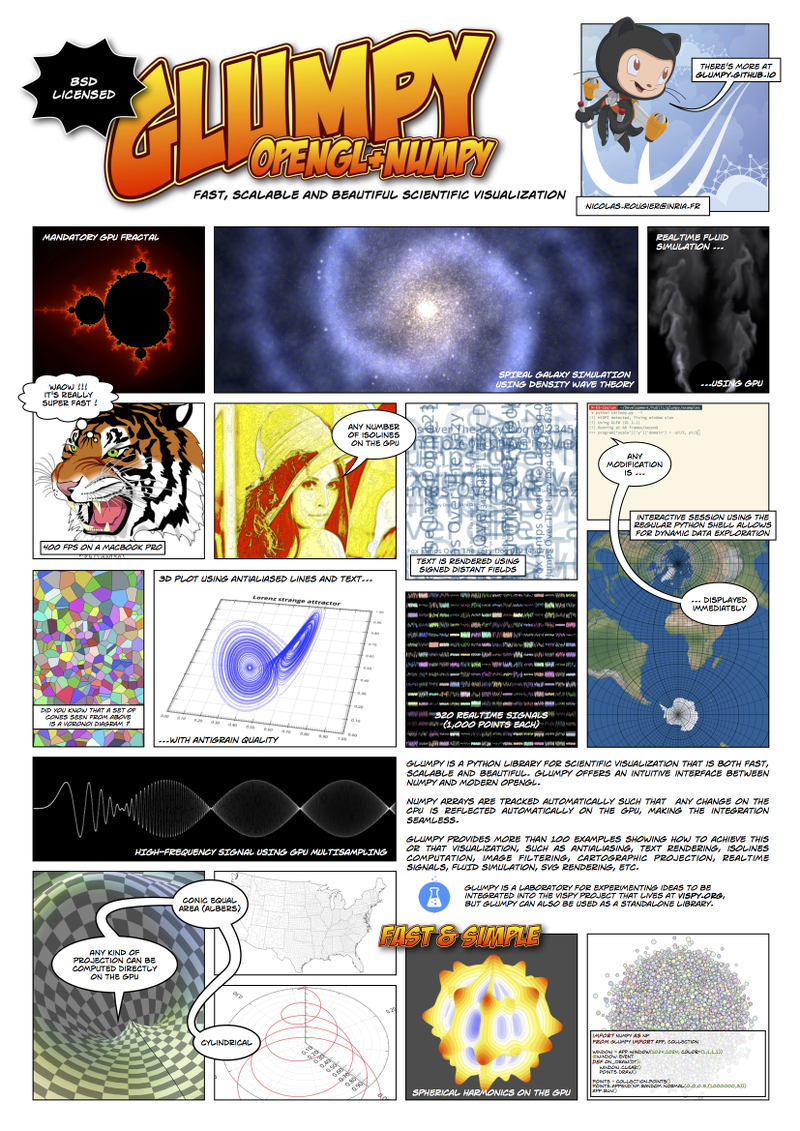glumpy is used as part of toast optical tomography library which provides python bindings. I ran a sample tutorial script and given below is the traceback.
Traceback (most recent call last):
File "", line 1, in
File "/usr/lib/python2.7/dist-packages/spyderlib/widgets/externalshell/sitecustomize.py", line 493, in runfile
execfile(filename, namespace)
File "/home/imaging/toast/script/python/tutorials/recon1.py", line 82, in
from toast import mesh
File "/home/imaging/toastpp/linux64/lib/python2.7/site-packages/toast/mesh.py", line 3, in
import tglumpy
File "/home/imaging/toastpp/linux64/lib/python2.7/site-packages/toast/tglumpy.py", line 5, in
from glumpy import figure, Trackball
ImportError: cannot import name figure
I get the same error when I type from glumpy import figure at the python prompt.
Given below is the script tglumpy.py. I can email this separately if you wish
import os
import numpy as np
import OpenGL.GL as gl
import glumpy as gp
from glumpy import figure, Trackball
from numpy import matrix
from scipy import sparse
from scipy.sparse import linalg
from numpy.random import rand
from types import *
import mesh
import pdb
class Mesh3D(object):
def init(self,hmesh,nim,cm):
nlist,elist,perm = mesh.SurfData (hmesh)
bb = mesh.MeshBB(hmesh)
bbmin = bb[:,0]
bbmax = bb[:,1]
bbcnt = (bbmin+bbmax)/2
scale = 2/np.max(bbmax-bbmin)
nlen = nlist.shape[0]
self.elen = elist.shape[0]
self.indices = np.zeros((self.elen,3), dtype=np.int32)
self.vertices = np.zeros((self.elen_3,3), dtype=np.float32)
self.normals = np.zeros((self.elen_3,3), dtype=np.float32)
for xi in range(self.elen):
d1 = nlist[elist[xi,1],:]-nlist[elist[xi,0],:]
d2 = nlist[elist[xi,2],:]-nlist[elist[xi,0],:]
nml = np.cross(d1,d2)
nml = nml/np.linalg.norm(nml)
for yi in range(3):
ns = elist[xi,yi]
nt = xi_3+yi
self.indices[xi,yi] = nt
for zi in range(3):
self.vertices[nt,zi] = (nlist[ns,zi]-bbcnt[zi])_scale
self.normals[nt,zi] = nml[zi]
if nim == None:
self.values = None
else:
self.values = np.zeros((self.elen_3,3), dtype=np.float32)
nmin = np.min(nim)
nmax = np.max(nim)
if nmin == nmax:
nmin = nmin-0.5
nmax = nmax+0.5
for xi in range(self.elen):
for yi in range(3):
ns = elist[xi,yi]
nt = xi_3+yi
v = (nim[perm[ns]]-nmin)/(nmax-nmin)
col = cm.get_color(v)
self.values[nt,:] = col._get_rgb()
def draw(self):
gl.glEnableClientState(gl.GL_VERTEX_ARRAY)
gl.glEnableClientState(gl.GL_NORMAL_ARRAY)
gl.glVertexPointerf(self.vertices)
gl.glNormalPointerf(self.normals)
if self.values != None:
gl.glEnableClientState(gl.GL_COLOR_ARRAY)
gl.glColorPointer(3, gl.GL_FLOAT, 0, self.values)
gl.glDrawElements(gl.GL_TRIANGLES, self.elen_3, gl.GL_UNSIGNED_INT, self.indices)
gl.glDisableClientState(gl.GL_VERTEX_ARRAY)
gl.glDisableClientState(gl.GL_NORMAL_ARRAY)
gl.glDisableClientState(gl.GL_COLOR_ARRAY)
def drawwire(self):
gl.glEnableClientState(gl.GL_VERTEX_ARRAY)
gl.glVertexPointerf(self.vertices)
gl.glDrawElements(gl.GL_TRIANGLES, self.elen_3, gl.GL_UNSIGNED_INT, self.indices)
gl.glDisableClientState(gl.GL_VERTEX_ARRAY)
class Mesh2D(object):
def init(self,hmesh,nim,cm):
nlist,elist,eltp = mesh.Data (hmesh)
bb = mesh.BB(hmesh)
bbmin = bb[:,0]
bbmax = bb[:,1]
bbcnt = (bbmin+bbmax)/2
scale = 1.5/np.max(bbmax-bbmin)
nlen = nlist.shape[0]
elen = elist.shape[0]
vertices = np.zeros((elen_3),dtype=[('position','f4',3)])
#for i in range(elen):
# for j in range(3):
# vertices[i_3+j] = nlist[elist[i,j]
# TODO!!!
self.elen = elist.shape[0]
self.indices = np.zeros((self.elen,3), dtype=np.int32)
self.vertices = np.zeros((nlen,3), dtype=np.float32)
self.values = np.zeros((nlen,3), dtype=np.float32)
if nim == None:
nim = np.zeros((mesh.NodeCount(hmesh),1), dtype=np.float32)
nmin = np.min(nim)
nmax = np.max(nim)
if nmin == nmax:
nmin = nmin-0.5
nmax = nmax+0.5
for xi in range(nlen):
for zi in range(2):
self.vertices[xi,zi] = (nlist[xi,zi]-bbcnt[zi])*scale
self.vertices[xi,2] = 1
v = (nim[xi]-nmin)/(nmax-nmin)
col = cm.get_color(v)
self.values[xi,:] = col._get_rgb()
for xi in range(self.elen):
for yi in range(3):
ns = elist[xi,yi]
self.indices[xi,yi] = ns
def draw(self):
gl.glEnableClientState(gl.GL_VERTEX_ARRAY)
gl.glEnableClientState(gl.GL_COLOR_ARRAY)
gl.glVertexPointerf(self.vertices)
gl.glColorPointer(3, gl.GL_FLOAT, 0, self.values)
gl.glDrawElements(gl.GL_TRIANGLES, self.elen*3, gl.GL_UNSIGNED_INT, self.indices)
gl.glDisableClientState(gl.GL_VERTEX_ARRAY)
gl.glDisableClientState(gl.GL_COLOR_ARRAY)
def drawwire(self):
gl.glEnableClientState(gl.GL_VERTEX_ARRAY)
gl.glVertexPointerf(self.vertices)
gl.glDrawElements(gl.GL_TRIANGLES, self.elen*3, gl.GL_UNSIGNED_INT, self.indices)
gl.glDisableClientState(gl.GL_VERTEX_ARRAY)
if name == 'main':
def ShowMesh3D(hmesh,nim,col,cmap,lighting,mode):
cm = gp.colormap.Grey
if cmap=='Hot':
cm = gp.colormap.Hot
elif cmap=='Fire':
cm = gp.colormap.Fire
elif cmap=='Ice':
cm = gp.colormap.Ice
elif cmap=='IceAndFire':
cm = gp.colormap.IceAndFire
wire = True
fill = True
if mode=='Wire':
fill = False
elif mode=='Fill':
wire = False
mesh = []
if type(hmesh) is list:
for i in range(len(hmesh)):
mesh.append(Mesh3D(hmesh[i],nim,cm))
else:
mesh.append(Mesh3D(hmesh,nim,cm))
window = gp.Window(800,800)
trackball = gp.Trackball(0,0,2)
@window.event
def on_draw():
gl.glClearColor(0,0,0,1)
window.clear()
trackball.push()
if lighting==True:
gl.glEnable (gl.GL_LIGHTING)
gl.glEnable(gl.GL_DEPTH_TEST)
gl.glEnable(gl.GL_BLEND)
gl.glBlendFunc (gl.GL_SRC_ALPHA, gl.GL_ONE_MINUS_SRC_ALPHA)
#I.shader.bind(I.texture,I._lut)
for i in range(len(mesh)):
if type(col) is list:
c = col[i]
else:
c = col
gl.glColor4f(c[0],c[1],c[2],c[3])
if fill==True:
mesh[i].draw()
if wire==True:
gl.glPolygonMode (gl.GL_FRONT, gl.GL_LINE)
gl.glEnable(gl.GL_POLYGON_OFFSET_LINE)
gl.glPolygonOffset (-1,0)
mesh[i].drawwire()
gl.glPolygonMode (gl.GL_FRONT, gl.GL_FILL)
gl.glDisable(gl.GL_POLYGON_OFFSET_LINE)
#I.shader.unbind()
trackball.pop()
@window.event
def on_init():
gl.glEnable (gl.GL_LIGHT0)
gl.glLightfv (gl.GL_LIGHT0, gl.GL_DIFFUSE, (1.0, 0.7, 0.5, 1))
gl.glLightfv (gl.GL_LIGHT0, gl.GL_AMBIENT, (0.2, 0.2, 0.2, 1))
gl.glLightfv (gl.GL_LIGHT0, gl.GL_SPECULAR,(1.0, 1.0, 1.0, 1))
#gl.glLightfv (gl.GL_LIGHT0, gl.GL_POSITION,(-1.0, 2.0, -1.0, 0.0))
gl.glLightfv (gl.GL_LIGHT0, gl.GL_POSITION,(-0.5, -0.2, -1, 0))
gl.glEnable (gl.GL_BLEND)
#gl.glColorMaterial(gl.GL_FRONT_AND_BACK, gl.GL_AMBIENT_AND_DIFFUSE)
gl.glColorMaterial(gl.GL_FRONT_AND_BACK, gl.GL_DIFFUSE)
gl.glMaterialfv(gl.GL_FRONT, gl.GL_SHININESS, 50.0);
gl.glEnable (gl.GL_COLOR_MATERIAL)
gl.glBlendFunc (gl.GL_SRC_ALPHA, gl.GL_ONE_MINUS_SRC_ALPHA)
gl.glPolygonMode (gl.GL_FRONT, gl.GL_FILL)
gl.glFrontFace (gl.GL_CW)
gl.glEnable (gl.GL_CULL_FACE)
gl.glShadeModel (gl.GL_SMOOTH)
@window.event
def on_mouse_drag(x, y, dx, dy, button):
trackball.drag_to(x,y,dx,dy)
window.draw()
@window.event
def on_mouse_scroll(x, y, dx, dy):
trackball.zoom_to(x,y,dx,dy)
window.draw()
window.mainloop()
def ShowMesh2D(hmesh,nim,cmap,mode):
cm = gp.colormap.Grey
if cmap=='Hot':
cm = gp.colormap.Hot
elif cmap=='Fire':
cm = gp.colormap.Fire
elif cmap=='Ice':
cm = gp.colormap.Ice
elif cmap=='IceAndFire':
cm = gp.colormap.IceAndFire
wire = True
fill = True
if mode=='Wire':
fill = False
elif mode=='Fill':
wire = False
mesh = Mesh2D(hmesh,nim,cm)
fig = figure(size=(800,800))
trackball = Trackball(0,0,2)
fig.push (mesh)
fig.show()
@window.event
def on_draw():
gl.glClearColor(0,0,0,1)
window.clear()
trackball.push()
gl.glDisable(gl.GL_DEPTH_TEST)
gl.glEnable(gl.GL_BLEND)
gl.glBlendFunc (gl.GL_SRC_ALPHA, gl.GL_ONE_MINUS_SRC_ALPHA)
#I.shader.bind(I.texture,I._lut)
mesh.draw()
if wire==True:
gl.glPolygonMode (gl.GL_FRONT, gl.GL_LINE)
gl.glColor4f(0,1,0,1)
mesh.drawwire()
gl.glPolygonMode (gl.GL_FRONT, gl.GL_FILL)
#I.shader.unbind()
trackball.pop()
@window.event
def on_init():
gl.glEnable (gl.GL_BLEND)
gl.glColorMaterial(gl.GL_FRONT_AND_BACK, gl.GL_AMBIENT_AND_DIFFUSE)
gl.glEnable (gl.GL_COLOR_MATERIAL)
gl.glBlendFunc (gl.GL_SRC_ALPHA, gl.GL_ONE_MINUS_SRC_ALPHA)
gl.glPolygonMode (gl.GL_FRONT, gl.GL_FILL)
gl.glFrontFace (gl.GL_CCW)
gl.glEnable (gl.GL_CULL_FACE)
gl.glShadeModel (gl.GL_SMOOTH)
#@window.event
#def on_mouse_drag(x, y, dx, dy, button):
# trackball.drag_to(x,y,dx,dy)
# window.draw()
@window.event
def on_mouse_scroll(x, y, dx, dy):
trackball.zoom_to(x,y,dx,dy)
window.draw()
window.mainloop()





